
Fort Snelling is a former military fortification and National Historic Landmark in the U.S. state of Minnesota on the bluffs overlooking the confluence of the Minnesota and Mississippi Rivers. The military site was initially named Fort Saint Anthony, but it was renamed Fort Snelling once its construction was completed in 1825.

Fort Ridgely was a frontier United States Army outpost from 1851 to 1867, built 1853–1854 in Minnesota Territory. The Sioux called it Esa Tonka. It was located overlooking the Minnesota river southwest of Fairfax, Minnesota. Half of the fort's land was part of the south reservation in the Minnesota river valley for the Mdewakanton and Wahpekute tribes. Fort Ridgely had no defensive wall, palisade, or guard towers. The Army referred to the fort as the "New Post on the Upper Minnesota" until it was named for three Maryland Army Officers named Ridgely, who died during the Mexican–American War.

The 2nd Minnesota Infantry Regiment was a Minnesota USV infantry regiment that served in the Union Army during the American Civil War.

The 3rd Minnesota Infantry Regiment was a Minnesota USV infantry regiment that served in the Union army during the American Civil War. It fought in several campaigns in the Western Theater.

The 4th Minnesota Infantry Regiment was a Minnesota USV infantry regiment that served in the Union Army during the American Civil War. It served in several important campaigns in the Western Theater.

The 5th Minnesota Infantry Regiment was a Minnesota USV infantry regiment that served in the Union Army in the Western Theater of the American Civil War.
The 7th Minnesota Infantry Regiment was an infantry regiment in the Union Army that served in the Western Theater of the American Civil War.
The 8th Minnesota Infantry Regiment was a Minnesota USV infantry regiment that served in the Union Army during the American Indian Wars and the American Civil War.

The 9th Minnesota Infantry Regiment was a Minnesota USV infantry regiment that served in the Union Army in the Western Theater of the American Civil War.

The 10th Minnesota Infantry Regiment was a Minnesota USV infantry regiment that served in the Union Army during the American Civil War.
Brackett's Minnesota Cavalry Battalion was a Minnesota USV cavalry battalion that served in the Union Army during the American Civil War.

The 3rd Minnesota Light Artillery Battery was a Minnesota USV artillery battery that served in the Union Army during the American Civil War and the American Indian Wars.

Fort Abercrombie, in North Dakota, was an American fort established by authority of an act of Congress, March 3, 1857. The act allocated twenty-five square miles of land on the Red River of the North in Dakota Territory to be used for a military outpost, but the exact location was left to the discretion of Lieutenant Colonel John J. Abercrombie. The fort was constructed in the year 1858. It was the first permanent military settlement in what became North Dakota, and is thus known as "The Gateway to the Dakotas".
The 25th Wisconsin Infantry Regiment was a volunteer infantry regiment that served in the Union Army during the American Civil War. During their service, they first participated in the Dakota War of 1862, then spent most of the rest of the war in the western theater.
The 30th Wisconsin Infantry Regiment was a volunteer infantry regiment that served in the Union Army during the American Civil War.

The Battle of Birch Coulee occurred September 2–3, 1862 and resulted in the heaviest casualties suffered by U.S. forces during the Dakota War of 1862. The battle occurred after a group of Dakota warriors followed a U.S. burial expedition, including volunteer infantry, mounted guards and civilians, to an exposed plain where they were setting up camp. That night, 200 Dakota soldiers surrounded the camp and ambushed the Birch Coulee campsite in the early morning, commencing a siege that lasted for over 30 hours, until the arrival of reinforcements and artillery led by Colonel Henry Hastings Sibley.

The US–Dakota War of 1862, also known as the Sioux Uprising, the Dakota Uprising, the Sioux Outbreak of 1862, the Dakota Conflict, or Little Crow's War, was an armed conflict between the United States and several bands of eastern Dakota also known as the Santee Sioux. It began on August 18, 1862, at the Lower Sioux Agency along the Minnesota River in southwest Minnesota.

Thomas Parke Gere was a Union Army officer who received the Medal of Honor for his actions during the Battle of Nashville in the American Civil War.
The Department of the Northwest was an U.S. Army Department created September 6, 1862 to put down the Sioux uprising in Minnesota. Major General John Pope was made commander of the Department. At the end of the Civil War the Department was redesignated the Department of Dakota. Immediately upon arriving in St. Paul General Pope sent letters to the Governors of Iowa and Wisconsin for additional troops to assist the 5th Minnesota Infantry Regiment. From Iowa he got the 27th Iowa Infantry Regiment and from Wisconsin he received the 25th Wisconsin Infantry Regiment. Both quickly crossed the border to assist with the uprising. The 25th Wisconsin was in Minnesota three months and the 27th Iowa was there a month before both headed south. After they departed, the Minnesota District would be garrisoned by Minnesota units: 5th, 6th, 7th, 8th, 9th, 10th Infantry Regiments, 1st and 2nd Minnesota Cavalry Regiments plus Minnesota Independent Cavalry Battalion as well as the 3rd Minnesota Light Artillery Battery. In 1864 companies of the 30th Wisconsin Infantry Regiment would see service in the Minnesota and Dakota Districts too.

William "Billy" Crooks was a Colonel during the American Civil War, member of the Minnesota House of Representatives, U.S. Military Academy graduate, and a veteran railroader. He led the 6th Regiment Minnesota Volunteer Infantry from August 1862 to October 1864, mainly contending against the Sioux. Crooks built the first rail line in the State of Minnesota, the St. Paul & Pacific. His first locomotive he named for himself the William Crooks 4-4-0 and began its operation in 1861. His operation was taken over by James J. Hill. The William Crooks would become the first locomotive of Hill's Great Northern Railroad.











